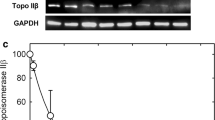Abstract
The interactions between selenium (sodium selenite), anthracycline antibiotics daunorubicin (DNR), and major contractile protein cardiac myosin (CM) were investigated. The results showed that the binding force between selenium and CM was 100 times stronger than that of DNR and CM. There was no marked influence on fluorescence intensity of DNR–CM at selenium concentrations of up to 20 μM. The co-administration of selenium (0.5–10.0 μg Se/ml) together with DNR resulted in a significant reduction in mice cardiotoxicity. However, selenium at the dose of 50.0 or 100.0 μg Se/ml afforded no obvious protection. The data indicate that selenium in the form of sodium selenite at appropriate dosage (<10.0 μg Se/ml) diminish the cardiac toxicity of DNR, potentially allowing the use of DNR at higher dosages in clinical cancer chemotherapy.




Similar content being viewed by others
References
Diplock AT (1992) Selenium, antioxidant nutritions, and human diseases. Biol Trace Elem Res 33:155–156
Gan L, Liu Q, Xu HB, Zhu YS, Yang XL (2002) Effects of selenium overexposure on glutathione peroxidase and thioredoxin reductase gene expressions and activities. Biol Trace Elem Res 89:165–175
Eltayeb AA, Liu Q, Gan L, Liu H, Xu HB (2004) Antagonistic effect of scutellarin on the toxicity of selenium in rat livers. Biol Trace Elem Res 98:253–264
Perez-Ruiz T, Martinez-Lozano C, Sanz A, Bravo E (2001) Simultaneous determination of doxorubicin, daunorubicin, and idarubicin by capillary electrophoresis with laser-induced fluorescence detection. Electrophoresis 22:134–138
Vetrivel KS, Dharmalingam K (2001) Isolation and characterization of stable mutants of Streptomyces peucetius defective in daunorubicin biosynthesis. J Genet 80:31–38
Minotti G, Menna P, Salvatorelli E, Cairo G, Gianni L (2004) Anthracyclines: molecular advances and pharmacologic developments in antitumor activity and cardiotoxicity. Pharmacol Rev 56:185–229
Ali MM, Frei E, Straub J, Breuer A, Wiessler M (2002) Induction of metallothionein by zinc protects from daunorubicin toxicity in rats. Toxicology 179:85–93
Cusack BJ, Young SP, Gambliel H, Olson RD (2002) Effect of aging on cardiac contractility in a rat model of chronic daunorubicin cardiotoxicity. Cardiovasc Toxicol 2:99–109
Lowey S, Risby D (1971) Light chains from fast and slow muscle myosins. Nature 234:81–85
Machackova J, Liu X, Lukas A, Dhalla NS (2004) Renin–angiotensin blockade attenuates cardiac myofibrillar remodelling in chronic diabetes. Mol Cell Biochem 261:271–278
Rupp H (1981) The adaptive changes in the isoenzyme pattern of myosin from hypertrophied rat myocardium as a result of pressure overload and physical training. Basic Res Cardiol 76:79–88
Nigris FD, Rienzo M, Schiano C, Fiorito C, Casamassimi A, Napoli C (2008) Prominent cardioprotective effects of third generation beta blocker nebivolol against anthracycline-induced cardiotoxicity using the model of isolated perfused rat heart. Eur J Cancer 44:334–340
Plandé J, Platel D, Tariosse L, Robert J (2006) Experimental study of dexrazoxane–anthracycline combinations using the model of isolated perfused rat heart. Toxicol Lett 161:37–42
Liu Y, Li BH, Sun XM, Lin AH (2009) Isolation and fluorescence spectrum of cardiac myosin from pig heart. Protein J 28:167–174
Shiverick KT, Thomas LL, Alpert NR (1975) Purification of cardiac myosin application to hypertrophied myocardium. Biochim Biophys Acta Protein Struct 393:124–133
Guo Z, Yang F, Zheng W, Bai Y (2005) Spectroscopic studies on interaction of Se(IV) with phycocyanin. J Jinan Univers-Natural Sci Med 26:390–395
Chen GZ, Huang XZ, Xu JG, Wang ZB, Zheng ZX (1990) Method of fluorescent analysis. Science, Beijing
Lakowicz JR (1983) Principles of fluorescence spectroscopy. Plenum, New York
Liu Y, Lin AH, Sun XM, Li BH (2008) Effect of zinc and copper on the interaction of daunorubicin with cardiac myosin. Biol Trace Elem Res 126:106–114
Wang H, Zhang J, Yu H (2007) Elemental selenium at nano size possesses lower toxicity without compromising the fundamental effect on selenoenzymes: comparison with selenomethionine in mice. Free Radic Biol Med 42:1524–1533
Zhang J, Wang H, Bao Y, Zhang L (2004) Nano red elemental selenium has no size effect in the induction of seleno-enzymes in both cultured cells and mice. Life Sci 75:237–244
Dvorska JE, Pappas AC, Karadas F, Speake BK, Surai PF (2007) Protective effect of modified glucomannans and organic selenium against antioxidant depletion in the chicken liver due to T-2 toxin-contaminated feed consumption. Comp Biochem Physiol C Toxicol Pharmacol 145:582–587
Romanowska M, Kikawa KD, Fields JR, Maciag A, North SL, Shiao YH, Kasprzak KS, Anderson LM (2007) Effects of selenium supplementation on expression of glutathione peroxidase isoforms in cultured human lung adenocarcinoma cell lines. Lung Cancer 55:35–42
Acknowledgments
This work was financially supported by Natural Science Foundation of Wuhan University of Science and Technology Zhongnan Branch (2010ZK005) and Academic Team of South-Central University for Nationalities: Ethno-Medicine Research and Development (XTZ09010). We also thank Liang Peng for the helpful comments on this article.
Author information
Authors and Affiliations
Corresponding author
Rights and permissions
About this article
Cite this article
Liu, Y., Li, Bh., Sun, Xm. et al. Effect of Selenium on the Interaction Between Daunorubicin and Cardiac Myosin. Biol Trace Elem Res 147, 240–245 (2012). https://doi.org/10.1007/s12011-011-9302-8
Received:
Accepted:
Published:
Issue Date:
DOI: https://doi.org/10.1007/s12011-011-9302-8




